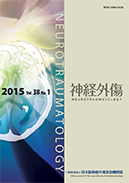38 巻, 1 号
神経外傷
選択された号の論文の10件中1~10を表示しています
- |<
- <
- 1
- >
- >|
原著
-
原稿種別: 研究論文
2015 年 38 巻 1 号 p. 1-8
発行日: 2015/09/10
公開日: 2020/04/27
PDF形式でダウンロード (2727K) -
原稿種別: 研究論文
2015 年 38 巻 1 号 p. 9-13
発行日: 2015/09/10
公開日: 2020/04/27
PDF形式でダウンロード (2016K) -
原稿種別: 研究論文
2015 年 38 巻 1 号 p. 14-19
発行日: 2015/09/10
公開日: 2020/04/27
PDF形式でダウンロード (2442K) -
2015 年 38 巻 1 号 p. 20-25
発行日: 2015/09/10
公開日: 2020/04/27
PDF形式でダウンロード (2079K) -
原稿種別: 研究論文
2015 年 38 巻 1 号 p. 26-32
発行日: 2015/09/10
公開日: 2020/04/27
PDF形式でダウンロード (2675K) -
原稿種別: 研究論文
2015 年 38 巻 1 号 p. 33-38
発行日: 2015/09/10
公開日: 2020/04/27
PDF形式でダウンロード (2311K)
症例報告
-
原稿種別: 症例報告
2015 年 38 巻 1 号 p. 39-44
発行日: 2015/09/10
公開日: 2020/04/27
PDF形式でダウンロード (2897K) -
2015 年 38 巻 1 号 p. 45-48
発行日: 2015/09/10
公開日: 2020/04/27
PDF形式でダウンロード (2215K) -
原稿種別: 症例報告
2015 年 38 巻 1 号 p. 49-53
発行日: 2015/09/10
公開日: 2020/04/27
PDF形式でダウンロード (3338K) -
原稿種別: 症例報告
2015 年 38 巻 1 号 p. 54-58
発行日: 2015/09/10
公開日: 2020/04/27
PDF形式でダウンロード (2502K)
- |<
- <
- 1
- >
- >|
